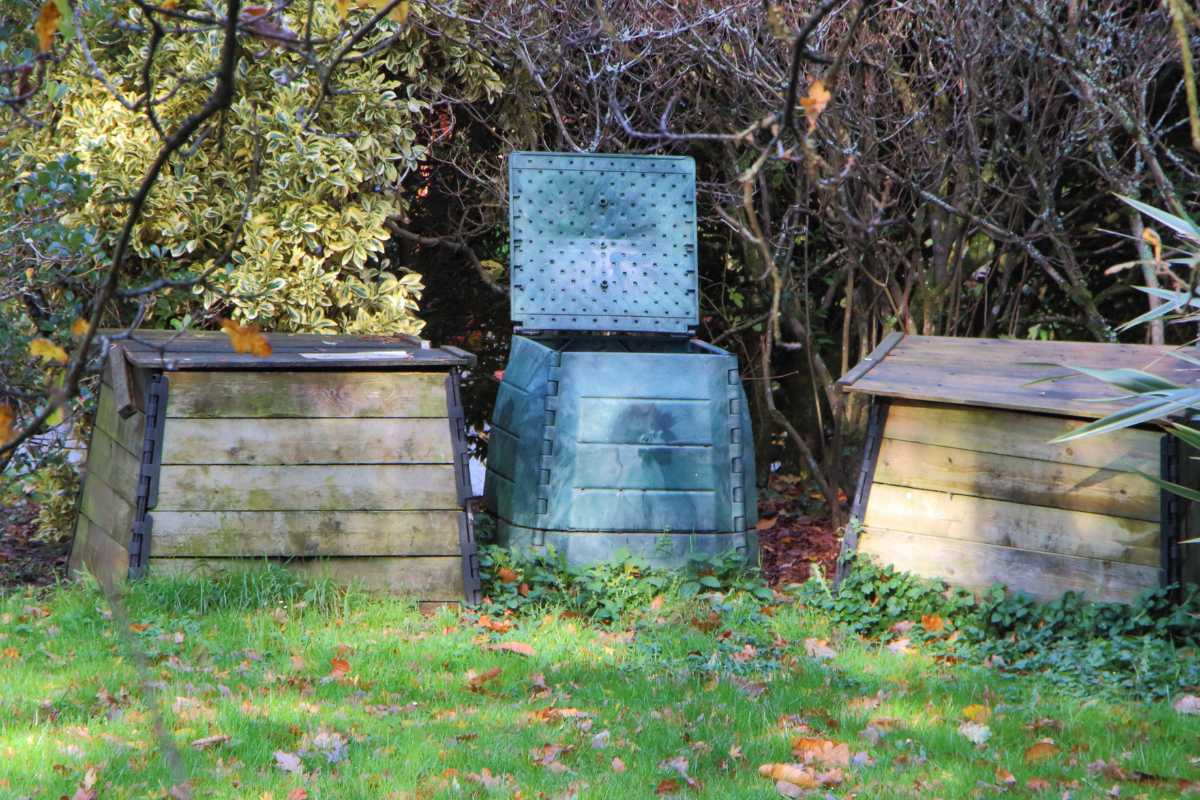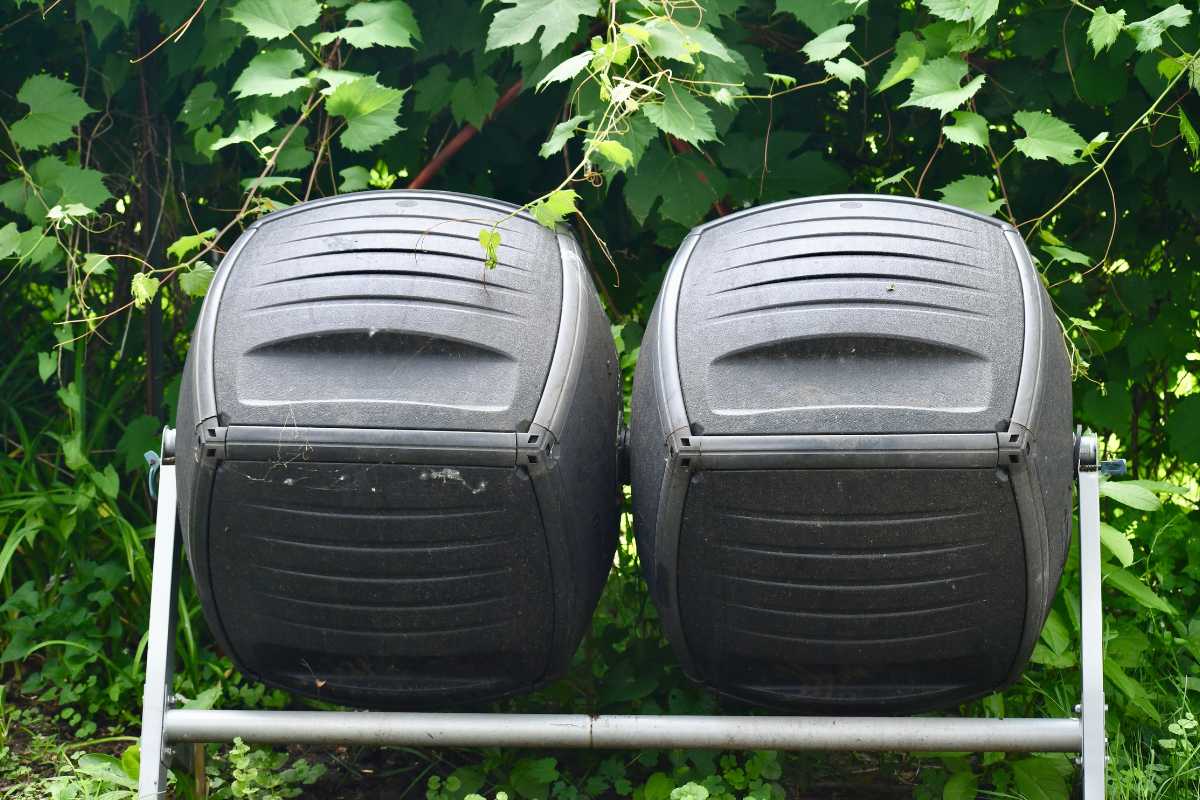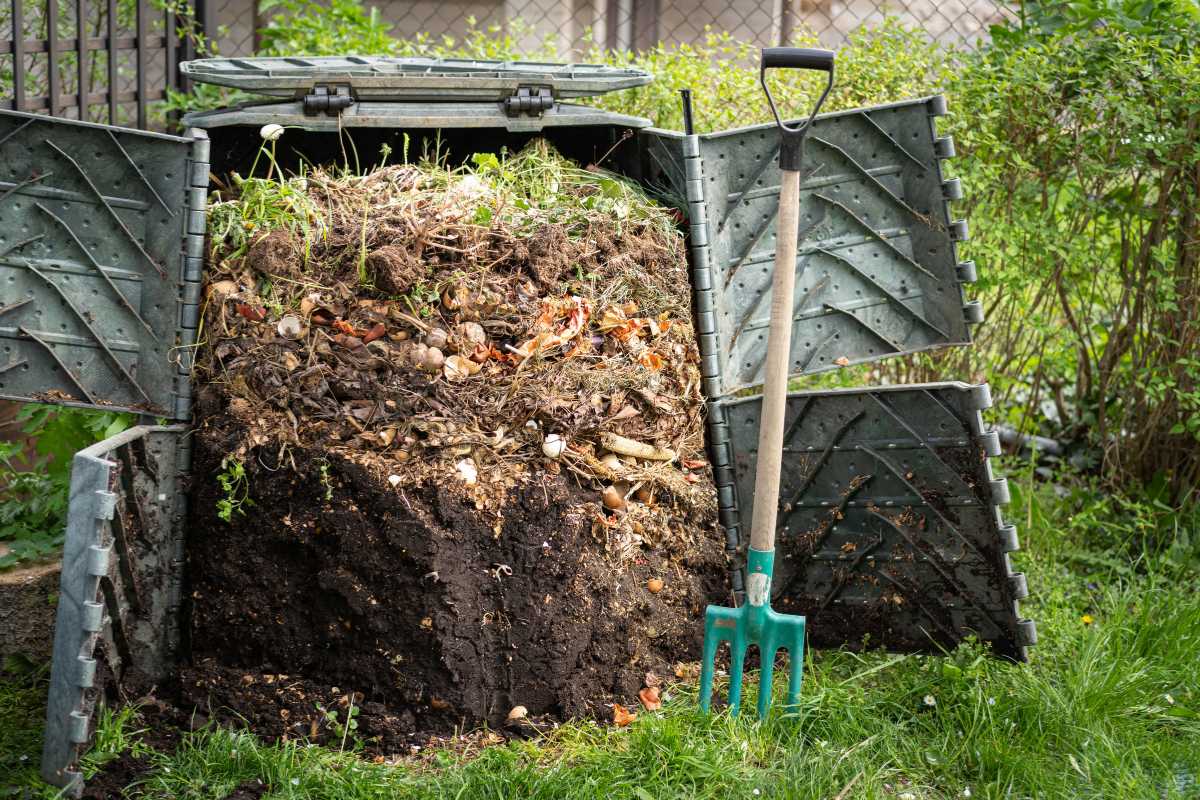There are many types of composters on the market. Choosing the right one for you will depend on your needs as well as your budget.
In the simplest form, you can make a compost heap of organic matter at the bottom of your garden that you dig over once a year to get to the rich compost that forms at the bottom.
In this article, I’m going to focus on the main types of composters available to buy online, the benefits and drawbacks of each, and which one might be suitable for you.
3 Main Types of Composters
If you’re composting outside, in addition to your main composter, you may want a small countertop compost bin to collect kitchen scraps that you can periodically empty into your compost.
Here is a cute one online that I like using for my food scraps.
It may be tempting to situate your compost bin near your kitchen, so you can add food to it regularly. But the best place to have it is at the bottom of your garden or near your vegetable patch. You’ll want a short journey with a wheelbarrow full of compost.
1. Compost Tumbler
This type of composter sits on legs and is fully enclosed. It is essentially a drum with a handle that allows you to turn over the compost contents easily.
It will enable you to mix up the compost inside, eliminating the need to dig over your compost heap.
For those who don’t necessarily want an unsightly compost pile, a tumbler are a good option. These units can also be mobile, so it’s not a stationary composter.
As you can easily aerate your compost by turning it regularly, you can create compost in weeks. This is definitely the fastest way to make compost.
One of the drawbacks is that these are at the pricier end of the market. You may also have problems if you are composting a lot of garden waste – especially if there’s lots of wood.
As they are enclosed, beneficial bugs won’t be able to get in, although they are not necessary for this type of composter. If you want to contribute more to the ecosystem, as well as get compost, an open bottomed bin would be a better choice.
You may want to add worms (red wigglers are the best for compost tumblers), but they are not essential to the composting process.
This type of composter is great if you have limited outdoor space or a mainly paved backyard. If you’re looking for faster composting, then this is the composter for you.
2. Compost Bin
Compost bins are usually closed at the top and open at the bottom to allow worms and bugs to access the compost.
They often have a bottom hatch that makes it easy to collect the well-rotted compost without having to turn the compost over.
The capacity of these bins is larger than that of the tumblers, so it is good if you have a lot of garden and yard waste, and kitchen scraps.
They can be made of plastic or metal. If you have an area of bare earth that you can situate your bin on, then this is the perfect composter for you.
They are usually the cheapest option to go for if you are buying a composter. It’s usually good to chop up your garden waste before adding it to your bin as this aids decomposition.
If you have a lot of wood to compost, then you may want to pair it with a wood chipper/shredder like this one.
3. Worm Factory
Worm factories, aka vermicomposting, tend to be a pretty low-capacity type of composter. They’re not as large as typical backyard compost piles.
Worm composting is suitable if your main source of organic material is from kitchen scraps, and paper and cardboard waste. They are not really large enough for garden waste.
Worm bins often have multiple layers of trays. These worm bins work by filling up a tray with compostable scraps, then adding worms.
As worms turn the organic waste (e.g., food scraps) in one tray into compost, they’ll migrate upwards into the tray above, leaving the finished compost in the tray below.
You then empty the compost tray and put it back on the top, filling it with recent waste for the worms to compost.
These types of worms composters can be kept indoors, so they are perfect if you live in an apartment and want an indoor composter for houseplants.
A great byproduct of vermicomposting is worm tea, which acts like a nutrient-rich liquid fertilizer for houseplants and your indoor garden. Worm castings are also a rich, organic soil conditioner.
Worm composters can also be a fun family activity if you have kids. Kids will love watching the worms move around and leave finished compost behind. Learn more about worms for composting.
The worms are usually sold separately. You can also usually buy extra trays for more capacity if you have more food scraps with a larger family.
How to Choose the Right Type of Composter

Composting is an excellent component of gardening and is the ultimate form of recycling. You can turn your garbage into nutrient-rich plant feed.
If you’re thinking of starting to compost, I absolutely recommend it. Whatever your home situation, there will be a composter type that will suit your needs.
- Related: Calculate How Much Compost You Need
First, think about how much waste you can compost. This is the most important factor as you don’t want a huge, half-empty, composter taking up space. On the other hand, you don’t want to have to throw out organic materials because you can’t fit them in your already-full composter.
If you have a large amount of yard waste to compost, a garden shredder can help reduce the space your garden waste takes up, as well as speed up the decomposition process.
Next, take into account your budget. There are a number of cheap composters on the market, but don’t underestimate the effectiveness of a roll of chicken wire for a more DIY composter solution..
Compost Location – Outdoors or Indoors?
Whether you want an indoor or outdoor composter will depend on your situation. If you have a backyard or community garden, you will want a high-capacity compost bin near your vegetable plot.
You will probably still want to have a small counter-top compost bin to collect your vegetable peelings and coffee grinds, so you won’t have to trek to your compost bin multiple times a day!
Apartment dwellers will want a compact composting solution that will provide you with a small amount of compost that suits your needs.
Consider the temperatures and weather around you too, especially if you have worms. Direct sunlight and cold weather could kill the worms.
If you have an outside space, I recommend going with an outdoor composter, but also consider your climate.
If you live in a hot climate, keep your compost bin wet and cool. If you live in a cold climate, bring your composter inside to keep it from freezing.
How to Choose the Right Composter Size

What composter size to get depends on how much compost you will need to use, as well as how much organic matter you have to compost.
The tumble composters can be emptied every month. But you may still need somewhere to store your compost somewhere before you dig it in at the end of the growing season – unless you are using compost regularly.
Gardens can create a lot of compostable materials, and some of these materials (like wood) break down very slowly. If you have many trees, you’ll have a lot of leaves. The bigger your garden, the bigger the compost bin you will need.
You may also create more kitchen waste than you realize. All vegetable peelings, fruit scraps, coffee grinds, and more can be added to your heap.
If you are in an apartment or you don’t have much outside space, then worm factories are perfect for your needs. They don’t take up much space and will provide you with small amounts of compost on a regular basis.
What Do You Plan To Compost?
Similarly to composter size, what you are composting will affect which composter you should choose.
For example, a 240-gallon composter will be overkill if you have a paved garden with only a few plants. A worm factory would be useless if you are regularly pruning trees or have a community garden.
Think carefully about what you have that you can compost, and bear in mind that there is an abundance of materials that you can add to your composter.
As well as garden waste, and raw fruit and vegetable scraps, you can compost cardboard, paper, feathers, hair, nail clippings, string, coffee grinds, teabags, animal manure, and more!
Composter Material

Most commercially available composters are made from heavy-duty plastic. These will last longer than wood, as any natural material will break down with the compost.
Metal compost bins are also available, but they may rust and also begin to break down after a few years.
The plastic bin will undoubtably outlive a bin of any other material, but wood and metal (like chicken wire) will still last for at least five to ten years.
If you want to be completely eco-friendly, it’s probably better to stick to ones made of wood or metal. But a plastic composter definitely wouldn’t be classed as a singe use plastic either as they’ll last for years.
The Right Composter For Me
Before you buy a composter, it is essential to assess your needs. Do you need a lot of compost to dig into a large area? Or are you after a small amount of compost for repotting houseplants?
If you do have outside space, having a compost bin with an open bottom placed directly onto soil will allow worms to access and break your compost down. This is good for the ecosystem as well as your garden.
Do you want to create compost fast and dig it into your garden regularly? Or do you want it to build up and be used at the end of the growing season?
Composting is a rewarding pastime, but it does take a lot of work to do it on a large scale. However, you will absolutely reap the benefits when you harvest your vegetables.
It is the most eco-friendly fertilizer that you can get, and you can ensure it is fully organic compost by controlling what goes into it. There really isn’t any reason not to compost!
For more articles on composting, check these out posts:






